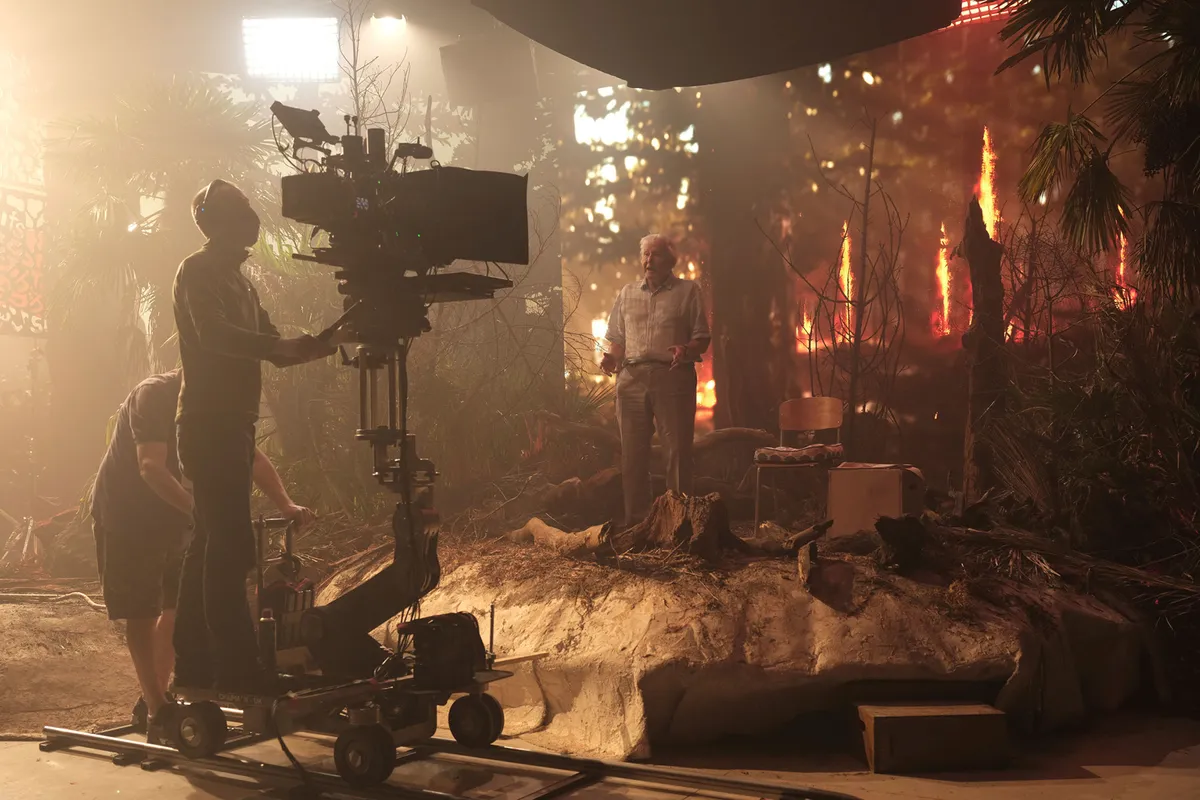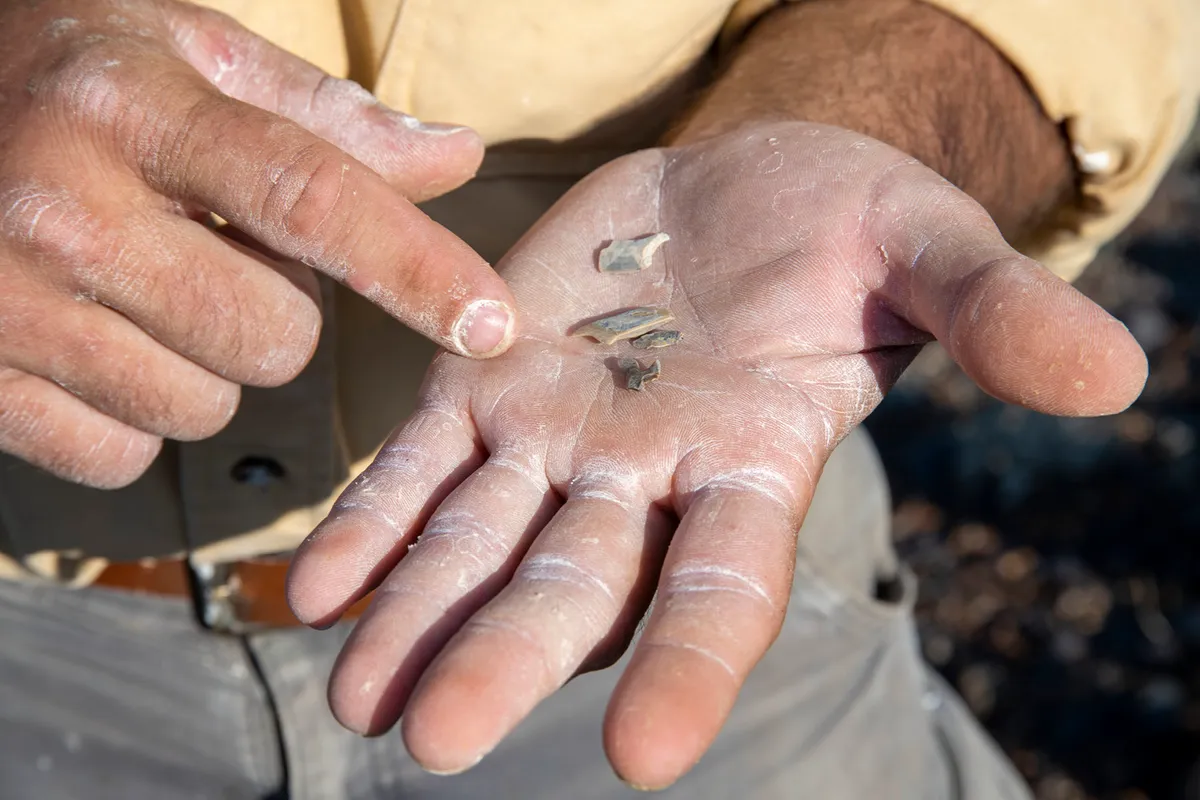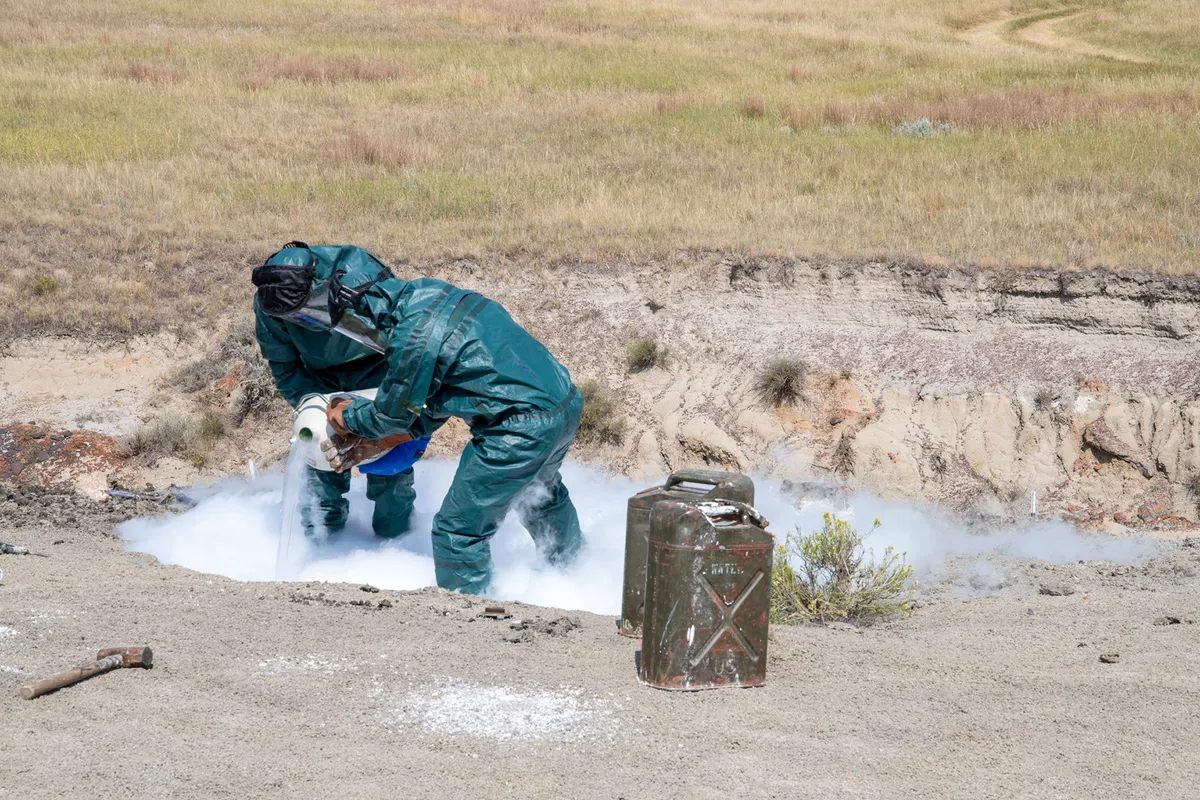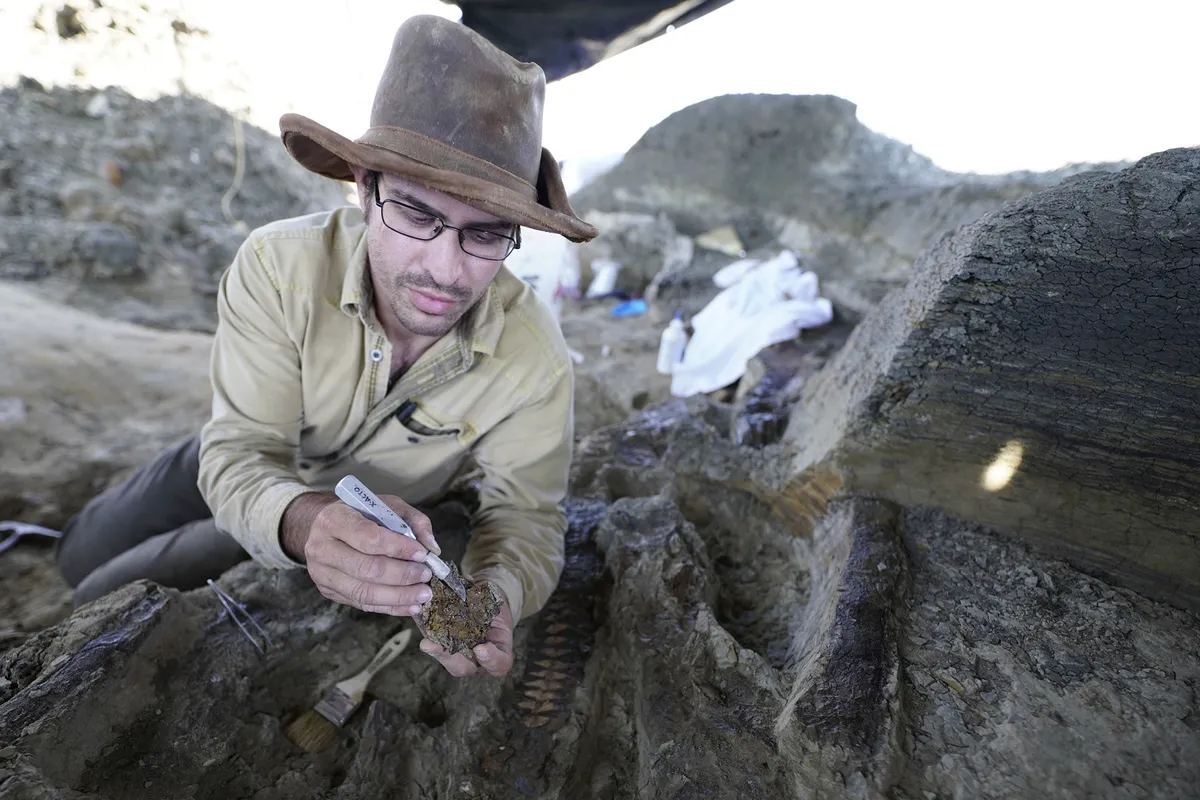Robert DePalma and his team are investigating the last day of the Cretaceous. That infamous day when a 10km-wide asteroid hit the Yucatán Peninsula at Chicxulub in Mexico, setting in motion a chain of events that led to the extinction of some of the biggest animals to have ever roamed the planet, the dinosaurs.
The evidence is stacking up, and at Tanis, a top-secret location in North Dakota, scientists are uncovering the first direct evidence, from the exact day, that the dinosaurs were wiped out 66 million years ago. The assemblage includes a dinosaur leg from a thescelosaur, a turtle impaled by a branch, a baby pterosaur, fossilised wood tangled with fish in a 'log jam', ammonite shells, triceratops skin, mammals, T.rex tracks, glass spherules and incredibly, maybe, a piece of the asteroid itself.
In a new BBC documentary presented by Sir David Attenborough, Dinosaurs: The Final Day, the last few minutes of the Cretaceous are reconstructed in stunning minute-by-minute detail. Researchers are gradually starting to unravel how events around the world are connected, and are uncovering secrets that have been hidden for the last 66 million years, at one of the most important fossil sites in the world.

A few days before the show aired, we spoke to palaeontologist Robert DePalma, to find out a little more about this prehistoric graveyard, and the day the asteroid changed our world forever.
How can we watch Dinosaurs: The Final Day?
This documentary is a gorgeous, vivid representation of that day, based on all the scientific evidence that we've put together. When I saw it, I was absolutely floored. Because, here's something that I had spent years reconstructing in my mind using all the data. I look at the screen, and I'm thinking, my gosh, this is what it probably looked like!
I think Dinosaurs: The Final Day is a phenomenal programme. It aired in the UK on 15 April 2022 and is currently available to watch on BBC iPlayer.
Dinosaurs: The Final Day is coming out in the US on 11 May 2022.
You've been studying a site that you've called Tanis. How was it formed?
It’s down to the very hard work of all of my co-authors, as well as Walter Alvarez - who figured out back in the 80s that we actually had an impact. We worked out the site was deposited during the fallout of coarse ejecta material from an asteroid impact.
I watched the documentary, and I was surprised at the very short timescales!
To give it probably the broadest span possible, we can say the site is constrained to the first 1-2 hours [after impact], maximum. Because that's how long ejecta would have been falling. Previously, most of our knowledge about that impact event was long-term; 75 per cent of species went extinct, we had atmospheric contamination, and all sorts of problems related to that.
But these are all long-term events in the fossil record. What happened right after impact? What was the first effect on Earth's biota? And how could that be integrated into what we know happened later? Those are all important questions that the site is starting to answer.
Read more about the dinosaurs:
- Absolutely everything you want to know about dinosaurs
- When did dinosaurs become birds?
- Dinosaurs wagged their tails while running, simulations reveal
Have you found any other evidence that the site was deposited right after impact?
We've actually constrained the site in multiple different ways. Including plants, pollen, marine dinoflagellates, different organisms, and by dating the glass. The impact glass can be radiometrically dated, and in this case, it dates to the very, very end of the Cretaceous. Basically, it correlates exactly with the Chicxulub impact event.

In addition to that, we have physics. The ballistic trajectories of all those ejecta spherules, these blobs of glass, that were thrown out of the crater [as vaporised and molten rock], out of the atmosphere, where this material cooled and solidified, then fell back to Earth in a rain of glowing glass droplets, or spherules. That's a known time span.
The spherules would have started to arrive at Tanis, tens of minutes after impact, raining down, for around an hour, two at most.
What is the significance of these spherules?
You're dealing with stuff that was molten by the impact, and they contain contamination from the impactor itself. So, you've got a fingerprint that ties the spherules with that specific impact. It's a literal fingerprint.
But some of those spherules were unaltered. In geology, what happens - is a nasty thing happens to glass. When glass goes into the ground, it absorbs water. Over time, glass turns to clay. But some of these spherules were trapped in amber before getting deposited. Just like an insect preserved in amber, the spherules were preserved [as glass]. And, in some, we're able to identify little fragments of stone. Most are calcium-rich, probably part of the carbonate platform from the Yucatán Peninsula.
But a couple of those fragments were wildly different. They were enriched in nickel, iron, chromium, and a few other elements that are not common here on Earth. The evidence is stacking up, and our preliminary analyses are supporting the fact that those two fragments probably came from the impactor itself!
How big are the fragments?
The spherules themselves are roughly 1-2 millimetres in diameter. And the fragments that we're dealing with are around half a millimetre. Look at the period at the end of a sentence, depending on your font size. That's basically the size!
How likely is it that a part of an impactor from so long ago, would actually survive?
Previously, a great researcher named Frank Kite described a fragment he thought came from the impactor, in a drill core brought up from the K-Pg boundary [an abbreviation for the Cretaceous-Paleogene boundary] in the Pacific. But it had been sitting in the ocean for so long, that it had degraded.
Frank was able to constrain it to a few types of meteoric body, but the fragment from Tanis doesn’t look like it experienced any sort of alteration or degradation. So far, it's our best shot at figuring out what the asteroid was made of, probably a carbonaceous chondrite. We were really, really shocked!
How were all the fossils preserved so well?
It appears much of the site was deposited by a massive surge of water, not long after the Chicxulub impact. This massive wall of water and sediment came into the river valley back in the Hell Creek Formation, and basically ‘locked in’ that period of time, like a snapshot into prehistory.

Why is Tanis unique?
We have a perfect storm at Tanis. Basically, the seaway that split the US in two at that time, was right along the border of Tanis, and the rest of the Hell Creek Formation. So essentially what you're seeing is an area of coastline, or an area close to the coastline. You don't get much of that in Hell Creek Formation.
So first, you've got preservation bias. You need to have the right dirt preserved from the right moment in time. And that dirt had to have been experiencing this massive sedimentation from the Tanis event. We suspect there are Tanis equivalents out there, in the fossil record. Some might have previously been identified as tsunami deposits.
How did an impact of 2,000 miles away cause a surge at Tanis?
Great question. At first, we saw all the hallmark signs of a surge. All the flow indicators showed this massive surge went essentially backwards up a river, inland! You don't see that too often. We looked at all the different diagnostic clues, and it looked like a tsunami to us.
But when you look at the numbers, it didn't match up. A tsunami coming from the crater [in Mexico] could not have reached Tanis [in North Dakota] quickly enough. It couldn’t have reached the site during that two-hour window, and would have taken around 18 to 20 hours.
Well, what did arrive there within that time frame? My esteemed colleague Mark Richards did the magic with that - he figured out that it was seismic waves. When we have the arrival of seismic waves, and a massive surge of water at the same time, the evidence seems to indicate that the surge was triggered, in some way, by the seismic waves.
And that’s not without precedent. It's happened multiple different times in recorded history; where an earthquake event causes a tsunami-like wave, we call it a seiche, many thousands of miles away – just minutes after that earthquake.

Tell us about the dinosaur leg. How did you feel when you saw that patch of scales emerging from the mud?
That surprise was absolutely genuine. I was excavating a fossil palm frond, and when the trowel flipped up a piece of matrix, and there were scales underneath, gleaming up at me, I thought, ‘oh, the day just got a whole lot more interesting!’
Whenever we find soft tissue out there, we're always on alert. Because that’s your golden moment to learn, and it's not always available to palaeontologists - we're used to dealing with bones, mostly. Soft tissue preservation opens up a whole new door for research. So, we were really excited. And as more and more was exposed, we were able to see that this was not just a patch of skin. There was a joint and a bone sticking out. And then eventually, a whole dinosaur leg!
While we can’t be 100 per cent sure this dinosaur died on that day, we can constrain it. So for example, we've got an articulated leg with soft tissue. Well, in a tropical to subtropical environment like Hell Creek, that would have decayed rapidly. Let's say it died weeks to months before the impact. If it had been sitting out there, decaying on the riverbank all that time, it would have deflated and flattened out, and become heavily decayed. Most probably, what we have, is an animal that died as a result of the surge, or right before.
What else can we learn from this dinosaur leg?
Firstly, it contains soft tissue features of the scales, that were unknown for that type of dinosaur. So we've got a much better idea of what that dinosaur looked like. Furthermore, that dinosaur existed right at that moment. Even if it died, for the sake of argument, months before; those dinosaurs existed right up until the end of the Cretaceous. So that helps us to answer a few questions. Were they still around? Were they already extinct? Or were they participating in that extinction event?
In addition to that, the fact that the leg had some tearing to the skin gives us an idea, probably, as to the forcefulness of the surge. We already know the surge was incredibly forceful, based on other animals and plants that were preserved. But this is just one more line of evidence; it was a turbulent surge that mirrors what we’ve seen in river floods today.
Where you've got a turbulent flood, you've got logs and large objects in that flood, and animals get caught up in that, almost like a meat grinder. They're literally ripped open in those events. And it appears something much like that could very well have happened here.
I have to mention the turtle…
Oh, the turtle, yes! It was totally unexpected. There was this little bit of shell sticking out and it turned out to be a whole turtle. We've got arms, legs, fossil skin, we've got the scales. And we were imagining this turtle, this poor thing, tumbling around in the surge. And then, we find that it’s skewered on the end of a branch. There is a slight chance it might have died within the weeks before the surge - as I mentioned, that's probably our longest timespan to consider, but it's more likely it died in the surge because of that impaling.
I feel sorry for the turtle, poor little thing! But it's a glorious little fossil. The shell is perfectly preserved, and that turtle is now able to tell us its own, personalised story as we continue to study it.

I felt quite sad, watching the reconstruction in the documentary.
I saw the writing on the wall when we were digging up the turtle. The minute we saw the branch going through the shell, we thought, oh, this poor thing! The branch goes in one end and out the other, out the leg opening. We can see both ends of this branch; this thing was thoroughly impaled. Our hearts really went out to the turtle. But now, the turtle is an ambassador. An ambassador of extinction, I guess we can say. Because it tells us a little bit more about the story.
And the baby pterosaur…
The baby pterosaur very unexpected, because it was found a little higher up in the surge deposit. It's still within the surge, we've got ejecta all over in the deposit, and it's underneath the K-Pg boundary clay, which is important to note. The K-Pg boundary clay is that clay layer packed with iridium, shocked quartz, and all those other things. So that's the fallout and gives you your cap of the site [the top of the strata].
Below that, in the surge deposit, we found this little object the size of a hen's egg. And at first we thought, well, okay, we've got this round object, could it be a nut or a seed from a plant or something? You don't go directly to the most outlandish explanation. But as it was prepared and put under magnification, we noticed these little delicate hollow bones. There was symmetry, and it was partially articulated. We realised that it was very similar to pterosaur embryos that have come out of Asia and elsewhere. Could this be what it was?
We consulted other pterosaur experts, including David Unwin, and it became clear to us at that point, that this was an unhatched pterosaur embryo. Pterosaur embryos are unknown from North America, they're unknown from the Late Cretaceous, and they're unknown from the particular type of pterosaur!
It was identified as an azhdarchid pterosaur. When Dave Unwin told me that, I thought, my gosh, it's from an azhdarchid?! And he says: yeah, Robert, it's from an azhdarchid, we get to study one, finally!
These creatures existed up until the end. This one died during the surge, or a little bit before. But its brothers and sisters might have hatched and witnessed the first days (or weeks) of the Paleogene, after the impact.
It would have hatched about the size of a bat, so it would have been this adorable, bat-sized little creature. We call them 'flaplings' when they come out of the egg, because they probably could have flown right out of the egg. I love the word.
But some animals did survive…
And we want to find out why. There’s a preserved burrow at the site, where a mammal dug through the surge deposit, after the surge. And we have bones of two mammals, the same species, same age, in that burrow. It's an interesting snapshot of how mammals were coping at that moment.
Without this impact event, if the dinosaurs were not taken out, it's possible that mammals would never have diversified to the extent they have, and humans might never have come to be. So, this is a really pivotal moment in our history as well.
If you could find one thing at Tanis, in your wildest dreams, what would it be?
My gosh. We found a handful of fossil feathers, so if we were able to find any sort of a feathered organism there, either a bird, or one of the feathered dinosaurs, I would be absolutely blown away! We know the preservation potential is there, so it's in the back of our minds that it could be just waiting there, in the outcrop, someplace.

In the context of what is happening today, can you explain why this narrative that you've uncovered is so important?
That brings the story full circle and highlights why the work at Tanis is so important. To paleonerds like myself, and my colleagues, we always want to know what happened at the end of the Cretaceous, the Chicxulub impact, and everything else. But to people who don't give a hoot about the Cretaceous, this is still important.
When you talk about mass extinction events, the Chicxulub impact was one of the top five. The other mass extinctions happened over tens of thousands, to millions of years. And geologically speaking, that's a mass extinction. But the Chicxulub impact happened rapidly. And this highlights the importance of hindsight, offered by the fossil record, to understand the reaction of our modern biomes to global-scale hazards.
These are not simulations. This is looking back into the past and using that window to see how these animals are going to respond, to better understand our current crisis. This could be very, very important to navigating the waters of our current environmental crisis. And as a species on the planet that's able to comprehend this, it's up to us to actually use the data to do that.
I think it’s so exciting that you’ve uncovered a whole narrative.
That's why it's a group effort. There’s no way one person, or one team, can do this alone. This project has inspired so many young researchers and assistants, people who have come out as students who are becoming palaeontologists in their own right. I can't wait to meet the new interns and such, that come out this summer. Because a lot of the work just wouldn't be possible without them. Hopefully, this project will continue as a team effort, because it is absolutely a phenomenal experience.
So what do we know about this day so far?
This day was very, very bad. You have a 10 kilometre-wide object hitting Earth at perhaps 20 kilometres a second. And, once that happened and all the ejecta was flying through the air, not long after, you would have felt ground shaking in North Dakota. The animals would have known something was wrong. Soon after that, these spherules fell from the sky in a glowing rain of hot molten glass.
And not long after that, if the animals weren't perturbed enough, they would have seen a massive surge of water come up the river valley, 10 and a half metres in height. But it wasn't beautiful tropical water. It was a muddy, roiling mass of death, with logs, branches, animals, and fish, all tumbling together. If you were unlucky enough to have been caught in it, you probably would have been killed instantly.
If you survived the surge, you essentially would have had a front-row seat to the end of the Cretaceous. Debris would have been falling out of the sky, the skies would have turned dark with the dust, and ash, and everything else, and you would have had three to 10 years of impact winter and ecological collapse.
Did you know straight away the significance of what you found?
We knew in steps. We were shown the site by Steve Nicklas and Rob Sula from Paleo Prospectors, who recognised that it was a magnificent site, due to the fish preservation. When I saw the site, I thought, my gosh, these fish, there's nothing like this in Hell Creek!
Then we started finding evidence that it was a surge event, with marine fossils in it. This is actually absolutely incredible! And then the ejecta shows up, oh my gosh. This is ejecta related to the impact. Our geochemical analyses and our radiometric dating link it to the impact.
And we're like, wow. Not only is it a surge, not only do we have these amazing creatures preserved, but it's linked to probably the most infamous day of the Mesozoic. And it was just wow, after wow, after wow.
About the expert, Robert DePalma
Robert is a palaeontologist and postgraduate researcher at the University of Manchester, and an adjunct professor at Florida Atlantic University.
Discover more amazing dinosaur facts: